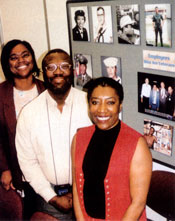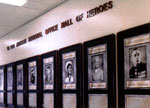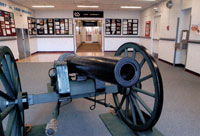|
College graduates understand the trade-off when they go into government. Their pay will be low, but in return they’ll get a chance to make a difference in the world. It turns out the young civil servants often get something else they didn’t bargain for: bad managers.
Researchers Amit Bordia and Tony Cheesebrough recently asked 25 Harvard University grads-turned-federal employees whether the agencies they worked for had good and capable managers. All 25 said no. As a result of this management failure, the Harvard alums say they often feel like their work doesn’t matter and that they’re not making a difference. Their supervisors either micromanage or leave them completely to their own devices. Managers don’t set clear expectations, share information, review performance, reward excellent employees or deal with poor performers. “My supervisor has no supervisory skills,” one Harvard alum said. “He’s a good person with a big heart, but this doesn’t translate to being a good supervisor.”
 |
| This article was featured in Government Executive. |
The civil servants whom Bordia and Cheesebrough interviewed work throughout government in a variety of positions. Their nearly uniform complaints about bad management echo the findings of survey after survey and study after study. At the Internal Revenue Service, half the employees say the agency is poorly run; 46 percent say their managers aren’t open and honest with them. Almost half of employees across the federal government said in a 1998 survey that their managers don’t take corrective action when their co-workers fail to meet performance standards. One respondent to an Agency for International Development survey described the situation this way: “Management has no idea what it wants its officers to accomplish, so it can give no guidance about what it thinks work requirements should be, nor how excellence might be judged. Since neither management nor staff knows what is to be accomplished, both of them float through the year and then invent requirements based on what was done, not what was expected.”
In the world of government, the talking heads are chattering more and more about civil service reform. They say the system—the rules, the regulations, the laws—in which federal managers manage their people needs to be changed to deal with the “human capital crisis” and boost government performance. But the latest private sector thinking holds that people stay with or leave managers, not organizations or systems. In the real world, a simple thank you, the knowledge that what an employee does makes a difference, and a manager who sets clear expectations are more important than the policies and the procedures in the personnel handbook.
Good managers in government already know that. They’re not waiting for the powers that be to fix the system—although they certainly wouldn’t mind if leaders made the rules less rigid. In the meantime, good managers are doing their best to set clear expectations for employees, share information, motivate workers, recognize good performance and help poor performers improve. They spend their days trying to make the work environment pleasant, getting employees the training they need, talking with employees about their work and making workers feel like their jobs makes a difference.
Stewart Liff is one such manager. As head of the Veterans Benefits Administration’s Los Angeles regional office, Liff has taken one of the worst-performing veterans offices in the country and made it 30 percent more productive, boosting both the satisfaction of veterans and the morale of the office’s employees. His approach relies on actions that are well within the power of any federal manager: share as much information with employees as possible, set clear expectations, base rewards on performance and create a positive, customer-focused work environment.
In government, there are good managers and bad managers. Even if the civil service is reformed, bad managers won’t make a good system work. So while members of Congress and political officials in the executive branch work on the system, federal executives and managers need to work on themselves.
Universal Principles
The employee was ROADkill—his government colleagues’ term for someone who is “Retired On Active Duty,” coasting into retirement, doing just enough work not to get in trouble.
James Knepshield, the employee’s manager, didn’t want to let him coast. Knepshield thought the employee was capable of good work, so he gave him a three-month assignment to prove it. “I am going to be checking on your progress,” Knepshield told him. “I’ll be 
James Knepshield |
your champion if you do well. If you don’t do well, I’ll do everything I can to help you move on to the next step” in life.
Three weeks later, the employee retired early, his coasting plans foiled. Knepshield had acted in a way the employee hadn’t expected: He did something. “He was surprised that anyone would do anything about it,” says Knepshield.
Knepshield is a manager at the Naval Air Systems Command Weapons Division in China Lake, Calif. Most of the 5,000 employees who work at the China Lake site, in the sparse Mojave Desert, and at a sister site in Point Mugu, Calif., along the Pacific coast, work under a special personnel system that could serve as a model for civil service reform across government. Essentially, the system aims to give managers increased flexibility to move employees around, reward excellent workers and punish bad performers. The China Lake system uses broad pay bands and a pay-for-performance system, and emphasizes tenure less than the standard federal personnel system does. It also features less rigid job descriptions than are usually found in government and other characteristics that reformers envision adopting across government.
The division’s personnel moved from the standard civil service system to their own model 20 years ago. Here’s what they’ve learned: Bad managers are bad managers under either system. Some managers say it’s easier to be a good manager in the reformed system than it was in the old one. But changing the system wasn’t a panacea for their management woes.
Knepshield, as deputy director for research and engineering at China Lake, sees both good and bad management in the ranks. When he sees bad management, the No. 1 problem is poor communication between supervisors and employees. “You may have a supervisor who feels like they’re communicating, but there isn’t evidence that there has been communication,” he says. When he sees good management, it’s because managers are honest, open and consistent. Good managers tell their employees what is expected and then tell them whether they are meeting expectations.
Effective managers don’t use a rubber stamp to evaluate employees. They use consistent principles, but give feedback in different ways, based on what they think is the best way to motivate each employee. For one worker who was very shy and nervous, Knepshield used a soft approach, weaving constructive criticism into discussions that accentuated the employee’s positive attributes. Another employee who was an overconfident chatterbox needed some blunt criticism, he says.
Knepshield makes sure that he recognizes strong performers, too. In one case, a very motivated employee took over a project from someone who had been receiving a lot of complaints from clients. The clients gave the new employee a lot of praise. “He is just doing an absolutely bang-up job,” Knepshield says. “He’ll be getting a nice salary increase.”
Limits And Limits
Knepshield’s ability to tie his employee’s salary to the employee’s performance is something that many federal managers complain they don’t have, because increases under standard federal personnel rules follow strict rules that emphasize tenure. But even if federal managers don’t have complete control over pay, they are not powerless to motivate and reward employees.
|

Smart Moves
Stewart Liff’s management moves mirror many of the recommendations of top leadership consultants. Some of Liff’s key actions:
- Replacing weak front-line supervisors. Strong front-line supervisors are key to successful organizations, management experts say. Liff says developing new front-line supervisors is the most important thing he has done to improve the office’s performance.
- Talking about and reinforcing the mission. Because of the pictures, posters and bulletin boards, there’s no question when someone walks into the Los Angeles veterans benefits office that they are in an office that serves veterans. Liff consistently reminds his employees why—and for whom—they are on the job.
- Measuring performance. Employees at the L.A. regional office get regular feedback about their performance from their managers—some, of course, more than others. Managers set clear expectations for employees and then keep them appraised of their progress.
- Rewarding employees. The L.A. office doesn’t have a huge rewards budget. So Liff provides little rewards—”employee of the month” recognition, an annual employee breakfast, thank-you notes that employees can share with one another. Management experts say employees crave praise.
- Spending time with employees. People want to see their leaders. Liff walks around the office almost every day.
|
In addition to using—or not using—pay and benefits, managers can boost their employees’ performance five other ways, according to WorldatWork, a Scottsdale, Ariz.-based group formerly known as the American Compensation Association. The association renamed itself two years ago to reflect a new emphasis on nonpay issues.
The five other tools are:
- Recognizing good work with such things as thank-you notes, plaques, on-the-spot awards and other forms of recognition.
- Emphasizing the balance of work and life through counseling programs, employee activities, telecommuting and alternative work schedules.
- Creating a positive office culture by promoting openness in the workplace, encouraging a specific leadership style, welcoming diversity and involving employees in decision-making.
- Providing opportunities for development, including training, coaching and career growth.
- Improving the environment, including the physical work space, the organization’s vision and its stature. In fact, more and more, compensation experts say that pay is just the baseline in motivating employees. As long as employees feel that their pay is generally in the same range as other people doing the same work, then other types of motivation become more important. The Gallup Organization, which has been studying employee motivation for 25 years, is even more specific: How long employees stay with an organization and how productive they are depend mostly on employees’ relationships with their immediate supervisors. Top performers, Gallup has found, want to know what is expected of them. They want to have the tools they need to get their jobs done. They want to know that their work matters and that they’re doing a good job—and they want to hear it from others. They want to talk about their progress and have opportunities to learn and grow.
Good managers give their employees those things. Bad managers don’t.
In the Bordia and Cheesebrough survey, the young federal workers said their managers weren’t doing the things that the WorldatWork or the Gallup experts say they should be doing. The workers’ comments included:
- ”Expectations are not clear and explicit. They either e-mail everything or nothing.”
- ”My boss is afraid to be creative and accepts mediocrity.”
- ”My boss micromanages a lot. He checks in almost hourly.”
- ”My supervisor is almost a free rider.”
- ”When I was new, my boss skipped over me in briefing meetings because he assumed I had nothing to contribute, but he never asked me.” Observers of federal management cite several reasons many managers don’t measure up. For one, people tend to be promoted for their skills as employees, not their skills as managers. For another, government organizations often don’t have clear goals and missions. That makes it hard for managers to set expectations for employees.
Many federal managers blame the system. They argue that they are hamstrung by federal personnel rules, by the budget process, by public perceptions of government inefficiency and by the political environment in which they operate.
Steven Kelman, a former Clinton administration procurement official and current Harvard professor who advised Bordia and Cheesebrough on their survey, says the causes of the poor management that young civil servants complain about are both systemic and individual. But while the prospects for systemic reform are hazy at best, individual supervisors can work on their own skills and their managers can help them get better. “The survey confirms the suspicion we have had for a long time that we do not do a good job of training supervisors,” Kelman says. “With better management, we can make some progress.”
Michael Abrashoff, a retired Navy captain who turned around the USS Benfold in the late 1990s, raising its retention rate from the worst in the Pacific fleet to the best, says his own transformation from a mediocre manager to a good one came when he decided to start managing. Rather than rule by regulation, Abrashoff got to know every one of the 300 sailors and officers on his ship, told them to make the Benfold the best ship in the Navy, and left it to them to figure out how to do it. He spent much of his time praising good performers and trying to turn around bad ones. He also made sure that he got sailors the tools they needed to do their jobs. The Benfold soon outperformed every other ship in the fleet on a variety of measures.
|
Strategic Rewards
The Office of Personnel Management has begun pushing a new way of looking at compensation called "Strategic Rewards."
Under the approach, managers must consider four factors that make a difference in recruiting and retaining employees. Two of them—compensation and benefits—are more a function of the federal personnel system than of managerial prowess. But the other two—development and work environment—are within managers’ control. If the government fixed its pay and benefits systems but managers didn’t address development and work environment issues, then federal agencies still would have trouble holding on to good workers.
Compensation
- Base salary
- Other payments
- Variable pay
- Paid time off
Learning and Development
- Training
- Learning experiences
- Career paths
Benefits
- Health care
- Retirement
- Savings
- Other insurance
Work Environment
- Work-life balance
- Leadership
- Performance culture
- Organizational climate
|
Abrashoff is now touring management conferences talking about his successes and has written a book called It’s Your Ship (Warner Books, 2002). The title is a metaphor that fits well with the first step management experts say supervisors need to take to improve their organizations’ performance.
To right their own ships, federal managers have to start steering.
|
Seeing Is Believing
When Stewart Liff arrived as the new chief of the Veterans Benefits Administration’s Los Angeles unit in 1994, he found an office that Charles Dickens might have designed.
“It was gloom, doom and despair,” Liff says. The office’s 450 employees had been toiling over veterans’ claims applications in the half-dark for two decades because many of the overhead lights were turned off during the oil embargo in the 1970s—and never turned back on. Cubicles and walls were painted bureaucratic gray, nicotine yellow and sickly green. “It looked like a damn dungeon in here,” says Richard Brandeburg, a Department of Veterans Affairs manager in California.
Piles of files towered over desks, tables and the floor. The ragged carpet was dotted with squares of different-colored fabrics held together by masking tape. “You could hopscotch on them,” Liff says. Workers were crammed on one side of the office while rows of file cabinets took up the other side, getting more natural light than most employees. “The file cabinets had the best view of Southern California in the office,” Liff says.
The poor physical conditions were matched by the office’s poor performance. Employees came to work in sweat pants. Poor performers spent a lot of time wandering around talking and not enough time processing claims, but they weren’t fired. Front-line supervisors had little credibility with their employees. Customer service scores were well below the national veterans benefits office average, while the claims backlog was well above the national average. During the 1980s and 1990s, the office somehow lost about 1 million files for a program that provides home loan assistance to veterans. And, not surprisingly, auditors said claims processors were making bad decisions on whether to grant benefits to veterans.

“This office was considered to be ultra-conservative,” says Terry Tracy, a veterans advocate for the American Legion in Los Angeles. “They would deny if they could deny.” In fact, veterans in L.A. were less likely to have their claims granted than were any other veterans in the country. In addition, the L.A. office’s rehabilitation branch helped only 60 veterans get retraining in 1994. “The culture and attitude was almost anti-veteran,” Liff says. “The attitude was almost, ‘If only these veterans would go away, we could do our jobs.’”

Images affirming and honoring veterans hang from the ceiling and line the walls at the Los Angeles veterans office. |
In the early 1990s, the Veterans Affairs Department considered shutting down the L.A. office altogether.
Today, the L.A. office—while still not the best—is one of the better regional veterans benefits offices in the country. Its customer service scores and quality ratings are above the national average. Claims processors eliminated much of their old backlog and are just as likely as processors elsewhere in the country to grant benefits. In 2001, the L.A. office’s rehabilitation branch retrained or got jobs for 376 veterans—six times the number of veterans helped in 1994.
Stewart Liff transformed the office from a bureaucratic nightmare into a rising star of the Veterans Benefits Administration while operating under the same bureaucratic constraints that executives throughout government do. He had to follow the same personnel rules, hiring processes, performance appraisal regulations and employee grievance procedures. What he did differently suggests that good managers can find a way to manage in any system, even one so widely criticized as the federal system. It also suggests that federal civil service reform—while it may help—is not essential to making the government work better.
Different Strokes
Liff’s management style draws upon his background as an artist. Picture a passion-filled young painter in New York with a fresh masters degree in fine arts. It’s the mid-1970s. He moves in art circles (though uncomfortably, as a middle-class guy from Queens) and paints at night in his New York studio. One day 25 years ago, with a wife to support, he decides to take a real job with the Veterans Administration. Though he spends the next two decades working his way up the management ranks, he remains a painter at heart.
What Liff knows from painting is that in a work of art, everything matters. The canvas, the initial sketch, the color scheme, the perspective, the texture and all the other details must work together. If one piece of the picture doesn’t fit, the whole work suffers. Liff has taken what he knows about painting and formed a management theory that he calls “visual management.” He believes that the elements of a workplace, like the elements of a painting, should all work toward the same vision, reinforcing the mission of the organization. In his view, a workplace that looks awful produces work that is awful.

A Civil War cannon is the latest "visual" added to the office. |
When Liff arrived at the L.A. veterans office, the picture he saw was dreadful. So he decided to redraw it. He started with the canvas, the physical office. Liff turned the lights back on. He had the office painted in bright shades of maroon and white. He replaced the carpets. He moved the file cabinets to the center of the room and the workers to the windows. He ordered that the piles of paper be filed away. He made sure the tools employees needed to do their jobs were close to their work areas—a move that discouraged employees from wandering around. Workers mirrored the change in atmosphere; they came to work in professional clothing. “They’ve come out of the dark and into the light—and they can be seen,” says Sherry Maxwell, a human resources specialist at the office.

Thabk-you letters from local lids welcome veterans seeking benefits. |
Then Liff moved to the foreground. In rooms where veterans come to receive services, Liff hung huge “Welcome” signs from the ceilings. He also hung large posters with pictures of veterans—Marines, soldiers, airmen and sailors—along with posters saying “We Honor Veterans” and “Grant When You Can.” He displayed the Prisoner of War flag.
Soon, employees started posting pictures of local war heroes on the walls. Bulletin boards with lessons on the history of veterans benefits were set up near the elevators. Local veterans started donating guns, medals, knives and clothes for hallway displays. Veterans came to the office and spoke with employees about their wartime experiences. Liff videotaped veterans of the 20th century’s major wars telling their stories, then set up a television monitor in the hall where people could watch them. Veterans set up 3-D life-size displays depicting a soldier in a Vietnamese prisoner-of-war camp, a World War II fighter in a bunker and nurses at a battlefield hospital. “The visual displays remind us who we serve,” says Deidre Dickey, a loan specialist at the office. “You get a sense that each case is a real person,” adds Robert St. Pierre, a claims processing trainee.
Performance Palette
Employees are also surrounded by images of their performance. Monthly reports showing how employees rank against each other on productivity measures are posted on the walls. Employees are identified by secret numbers rather than names, but they can see how they stack up against their peers, and how they are performing relative to the goals that have been set for their work groups. Graphs and charts on bulletin boards show how work groups compare with each other, how the office’s overall performance has changed each month and how the office rates against other veterans benefits offices across the country.
“Everyone knows what they have to do every day,” says Mary Freeman, a front-line supervisor, or coach, as her position is called at the office. “It’s not going to be a surprise when a coach calls someone in to talk about performance.”
Employees say they like knowing where they stand. That’s particularly true of top performers, who received little feedback prior to Liff’s tenure. Liff hangs the pictures of high-performing individuals and work groups each month near the employee meeting room. To Liff, the posting of performance indicators is another part of the visual management system, designed to constantly focus employees on the mission of the organization—serving veterans. Images posted around the office concern everything from top-level strategic plans to the minutiae of day-to-day performance. On the top level, one illustration Liff drew and hung in the office shows a yellow brick road charting the office’s major goals from 1995 to 2001, while another depicts a rocket flying through goals for the next few years. At the lowest level, television monitors throughout the office turn red if a veteran has been waiting on the phone for more than three minutes. Not coincidentally, veterans spend less time on hold today than they did a few years ago.
“When you visit most offices, do you get a sense as to what the goals and objectives are? I think not,” Liff says. “Most of the time, they are hidden in books, binders or someone’s drawer. The less attention they get, the less likely it will be that an organization will be able to achieve them.”
Liff’s management philosophy isn’t limited to pretty pictures. He gets rid of people who don’t meet minimum standards or engage in misconduct. He has fired numerous poor performers and bad apples—or encouraged them to move on—during his tenure. He refuses to accept the conventional wisdom that poor performers in the federal government cannot be fired. “You’re not going to keep your best people, they’re not going to want to stay, if your weakest people are not being dealt with,” he says.
Liff also moved more than half of the front-line supervisors at the office into nonsupervisory jobs or replaced them. He says they lacked credibility because they had failed to deal with performance problems or recognize strong performers. Worse, managers didn’t treat employees with respect, so employees responded with poor attitudes. “None of those people were bad people,” Liff says. They were just bad supervisors. He found other employees with leadership potential and trained them as coaches and supervisors.

Stewart Liff |
Liff himself tries to send messages that he cares about the office and its employees. He holds a thank-you breakfast for employees each year. He walks around all the time, observing operations and talking with employees and supervisors about their performance. (Everyone calls him “Stew.”) Walking around, Liff says, allows him to keep his finger on the pulse of the office and helps him come up with new ideas for improving the workplace. “Employees desperately want to see their leaders as frequently as possible,” he says. “It provides them with a high degree of confidence.”
The Dark Side
Liff’s efforts have not resulted in a complete turnaround at the L.A. office. Like veterans benefits offices across the country, the L.A. operation saw its backlog of claims applications double almost overnight after a recent court decision and legislative changes. The heavy workload is taking a toll on the office’s workforce, which was downsized from 467 to 324 employees over the past eight years. A high percentage of trainees—hired in the past two years after a decade of almost no hiring—means many workers aren’t operating at their maximum potential. “It takes three to four years for employees to be comfortable with what they’re doing here,” says Donald Myles, a claims processor.
Not all of the new front-line supervisors at the office have the confidence of employees yet.
Alberta Franklin, the local union president, says some managers aren’t providing enough guidance to their employees to help them improve performance. In addition, not every employee has bought into Liff’s vision. Preventing employees who have resisted his changes from poisoning the workplace is an ongoing challenge for Liff. “There are a core of cynics who are the last bastion of an institution that is gone with the wind,” Liff says.
But the cynics are being replaced by new employees who don’t know the L.A. office as anything but the operation that Liff created. “There are always going to be people who are set in their ways,” says Sue Nguyen, a claims processing trainee. “You hear the same complaints about management in any workplace.”
Liff’s success shows that managers who set expectations, motivate and develop employees can improve their offices’ performance, even in the federal system. Liff operates under the same constraints as other federal managers. In high-priced L.A., for example, he has to compete with the lofty salaries offered by private sector employers.
Then again, Liff isn’t looking for people who are motivated by pay alone. The employees he has hired recently say they were attracted to the veterans office because they think they can make a difference. “I made the move to government for other reasons than private sector rewards. Anyone who made the move to the government sector expecting those rewards was either misled or was naive,” Nguyen says. “If you’re in this business, the true reward is being able to serve the veterans who gave us our freedom.”
That attitude fits right in with Liff’s vision for the L.A. veterans office.
|

You Can Manage Your Way Out
